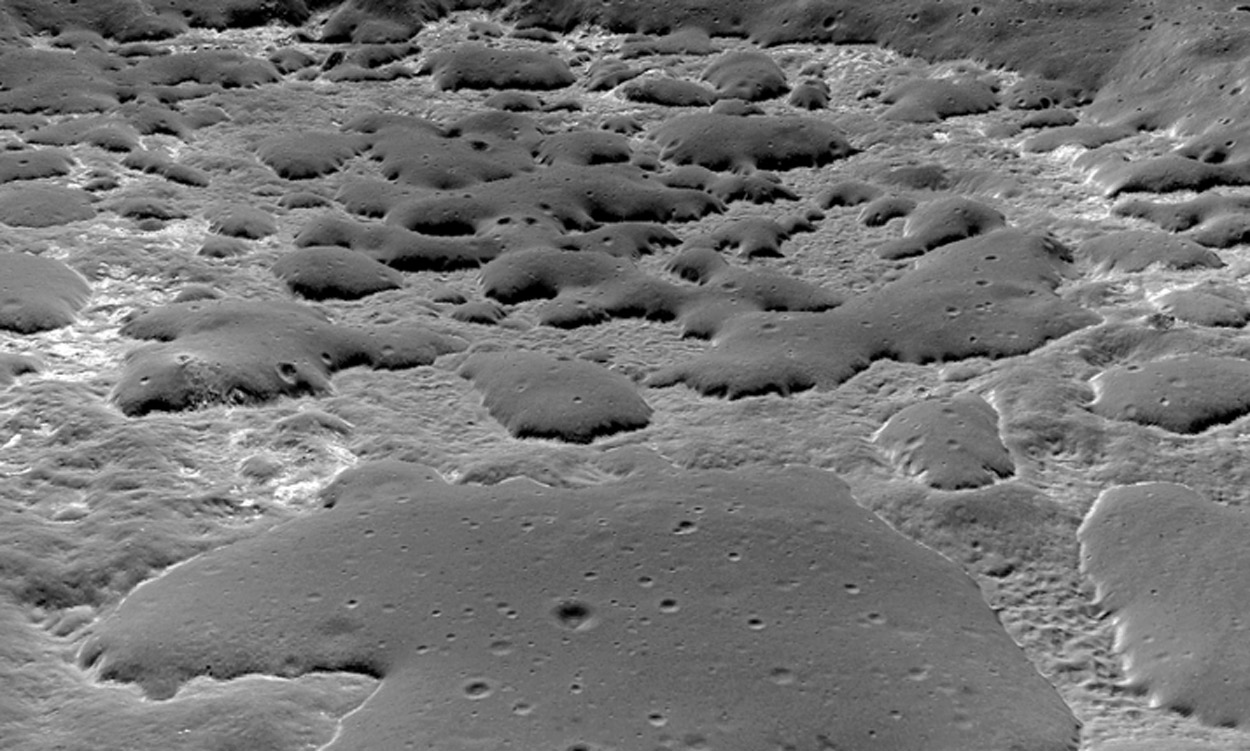WCU professor takes part in NASA’s latest lunar land/rover instrument suite

Perspective view Ina with 3x vertical exaggeration composed of Lunar Reconnaissance Orbiter Camera (LROC) Narrow Angle Camera (NAC) image M119815703 on top of an LROC NAC Digital Terrain Model. Credit: L. Qiao [NASA/GSFC/Arizona State University
By Julia Duvall
Amy Fagan, associate professor in the College of Arts and Sciences at Western Carolina University, is once again bringing her expertise to a team of fellow scientists working on a new initiative for NASA.
Fagan and fellow scientists, along with leading principal investigator Scott Anderson from the Southwest Research Institute’s Solar System Science and Exploration Division, are part of a team working on NASA’s new DIMPLE instrument suite.
The instruments that comprise DIMPLE, short for Dating an Irregular Mare Patch with a Lunar Explorer, will investigate the Ina Irregular Mare Patch, discovered in 1971 in Apollo 15 orbital images.
“We've got a full team from lots of different organizations and backgrounds coming together to work on this initiative,” Fagan said. “We've got some that are lunar geologists, some that have expertise in chemistry, and those with expertise more the age dating/morphology of these types of features. My expertise and how I fit into the team is general geology of the moon and the specific formation of samples.”
The $50 million DIMPLE instrument suite, which will be hosted on a commercial lunar lander/rover to be selected by NASA, is designed to understand if the moon has been volcanically active in the geologically recent past. DIMPLE will use cameras and radioisotope-based dating to determine the age and composition of an anomalously young-looking patch of basalt named Ina.
Rocks at Ina will be dated using the first-ever, purpose-built radioisotopic rock dating instrument for use in space, called the Chemistry Organic and Dating EXperiment or CODEX. CODEX is the result of two decades of development at the Southwest Research Institute.
“The DIMPLE instrument suite was proposed to the third round of NASA’s PRISM program, which stands for Payloads and Research Investigations on the Surface of the moon,” Fagan said. “For the first two rounds of PRISM, NASA dictated a very specific location, but for this third competition, we had more flexibility and were able to propose the exciting scientific objectives we wanted to address at Ina.”
The selection of DIMPLE was announced in July 2023.
PRISM sends science investigations to the Moon through a NASA initiative called Commercial Lunar Payload Services. This PRISM call was the first that allowed proposers to choose and justify a particular landing site for conducting high-priority lunar science investigations.
“Exploring and getting more information about this irregular mare patch on Ina will address questions we have about the moon’s evolution as well,” Fagan said. “With DIMPLE, there are no humans involved in the collection/photographing of the samples, only robot. The three things we are determining on this irregular mare patch on Ina are age dating, chemistry of the rocks and the characterization of the rocks. We are not bringing samples back to Earth, but we are still getting a trove of data and images to analyze.”
Fagan has also been part of previous NASA initiatives, most recently serving on the NASA moonwalking test mission team for Artemis III which is part of the Artemis missions.
“While I was part of the moonwalking test mission team and helping with astronaut simulations, this has been a different experience because there will not be humans on the surface, it will be robotic instrument suites,” Fagan said. “NASA has been supporting robotic initiatives since the 60s and 70s in addition to the astronaut-led trips to the moon, so I am proud to be part of continuing this work.”
Fagan said that Ina is one of the best-known irregular mare patches on the surface of the moon.
“What's interesting about it is that there's two different theories about its formation; some people think that based on some of its morphology that it is around 33 million years old whereas other people think it is around 3 billion years old,” Fagan said. “That is a really big discrepancy and we do not yet have a good understanding about how these irregular mare patches formed.”
In order to get more information about Ina and a more accurate age, a camera, sample collection arm and the CODEX instrument will remain on the lander, while a rover equipped with a camera and rake will scoop and transport samples back to the lander instruments for detailed study. The DIMPLE team also includes The Aerospace Corporation, the University of Bern, Colgate University and Lockheed Martin.
In 2024, NASA plans to work on issuing a CLPS task order to determine the lunar lander and rover provider to deliver DIMPLE to the moon.
“Commercial space providers will give their proposals to NASA to be the service provider to send DIMPLE to the moon,” Fagan said. “Essentially two programs come together to make this happen.”
The delivery date for DIMPLE to the moon is scheduled to occur in 2027.

